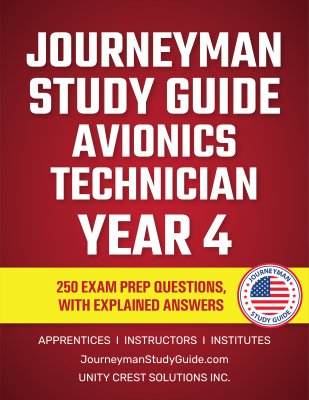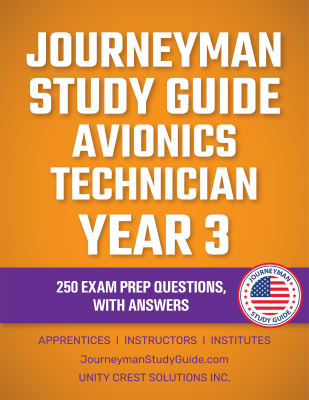Questions, Answers, & Explanations
Get clear explanations behind every answer, perfect for deeper learning and more thorough exam preparation.
Site Updates in Progress: Things might look different as we work on enhancing your experience.
What is an Avionics Technician?
An Avionics Technician specializes in the installation, maintenance, and repair of electronic systems used in aircraft. This includes communication systems, navigation systems, radar, flight control systems, and other electronic equipment critical for aircraft operation. Avionics technicians ensure that these complex systems are fully operational, safe, and comply with strict regulatory standards. As aviation technology continues to advance, the demand for skilled avionics professionals is growing, particularly in commercial aviation, defense, and private aircraft sectors.
Key Responsibilities
As an Avionics Technician, you will be responsible for various tasks related to the upkeep and functionality of aircraft electronic systems. Your duties may include:
Skills and Traits for Success
Avionics technicians must possess a unique set of skills and attributes to succeed in their work:
Industries Where Avionics Technicians Thrive
Avionics technicians play a pivotal role in several industries, including:
Why Choose This Career?
The field of avionics offers numerous benefits and opportunities for professionals:
Get Ready for Your Career in Avionics!
Are you ready to take the next step towards becoming a skilled Avionics Technician? Our Q&A guides, Q/A Explanations, and Online Tests are here to help you master key concepts in avionics and prepare you for certification exams.
What to Expect on the Certification Exam
The Avionics Technician certification exam evaluates a candidate's technical knowledge, practical skills, and understanding of industry standards in avionics systems. This exam is designed to test your proficiency in diagnosing, repairing, and maintaining complex electronic systems used in aircraft, ensuring that aviation professionals meet the highest safety and performance standards. Certification is typically issued by organizations like the Federal Aviation Administration (FAA) or industry groups such as NATE (National Association of Tower Erectors) and IA (Inspection Authorization) examiners.
Exam Format
The Avionics Technician certification exam typically consists of multiple-choice questions and practical applications that test your knowledge of electronics, aircraft systems, and regulatory requirements. Here’s what you can expect:
Key Topics Covered
Passing Requirements
To earn your Avionics Technician certification, a minimum passing score of 70% is typically required. This demonstrates your competency in key areas such as electronics, diagnostics, and compliance with industry standards. The exam assesses both theoretical knowledge and practical problem-solving skills.
Tips for Preparing Effectively
Preparing with the Right Tools
Ready to take the next step toward becoming a certified Avionics Technician? Our Q&A, Q/A Explanation, and Online Test products are designed to help you prepare for your exam and succeed in your career. Whether you need a quick self-assessment or a deep dive into key concepts, our study materials are tailored to meet your needs.
What Types of Questions Are on the Certification Exam?
The Avionics Technician certification exam is designed to assess both the theoretical and practical knowledge required to maintain and repair avionics systems. The exam features a combination of multiple-choice questions, scenario-based questions, and hands-on assessments. These questions test your understanding of the systems, troubleshooting techniques, and regulatory requirements in the avionics field.
Common Question Formats
The Avionics Technician exam includes several question types to assess your readiness for the role:
Sample Questions
To help you better understand the format and content of the exam, here are a few sample questions based on common topics covered:
1. Avionics Systems
Question: What is the primary function of the Automatic Dependent Surveillance–Broadcast (ADS-B) system in modern aircraft?
Answer: C) To enhance navigation and situational awareness
2. Diagnostic and Troubleshooting
Question: If a communication system in an aircraft fails, what is the first step in diagnosing the problem?
Answer: B) Inspect the wiring and connections for loose or damaged components
3. Electrical Systems and Components
Question: Which type of tool is commonly used to measure the electrical resistance of an avionics component?
Answer: A) Multimeter
4. Regulations and Standards
Question: According to FAA regulations, how often should avionics systems be calibrated for accuracy?
Answer: D) As determined by the manufacturer’s maintenance schedule
Tips for Answering Exam Questions
Practice Questions for Better Preparation
Our Q&A with Explanation guide is the perfect resource for preparing for your Avionics Technician certification exam. The guide provides you with structured practice questions, and the Q&A Explanation helps clarify the reasoning behind the correct answers.
In addition, our Online Tests offer an interactive experience, simulating the actual exam environment. This allows you to test your knowledge in real-time and track your progress as you prepare.
Preparing with the Right Tools
Our study guides are designed to help you prepare for the Avionics Technician certification exam by providing targeted practice questions and thorough explanations of each answer. Whether you're just starting your study journey or need to refine your knowledge before the exam, our resources can help you succeed.
Morning: Preparing for the Day
Midday: Operating, Troubleshooting, and Repairing Systems
Afternoon: Testing, Repairing, and Quality Control
Typical Work Environments
Challenges and Rewards
Earning Potential
The earning potential for Avionics Technicians varies depending on experience, skill level, and geographic location. Below are typical salary ranges for professionals in this field:
Regional Salary Differences
Salaries for Avionics Technicians can differ significantly based on location. Below is a breakdown of salary trends across the U.S.:
Career Growth Opportunities
Some of the common career advancement routes include:
The Benefits of Certification
Here are some of the key benefits:
Success Stories
Here are a few inspiring stories:
Preparing for Your Career in Avionics
Embarking on a career as an Avionics Technician offers many opportunities for professional growth and personal satisfaction. Whether you’re just starting your career or looking to advance, there are numerous resources to help you along the way. Our study guides, Q&A explanations, and online tests are specifically designed to help you gain the knowledge and confidence you need to succeed in the Avionics Technician certification exam.
General Wage Ranges
Salaries for Avionics Technicians vary depending on experience, location, and industry. Below are typical salary ranges for avionics technicians in the U.S.:
Regional Salary Differences
Salaries for avionics technicians can vary by location due to industry demand and local economic conditions. Here's a look at how wages differ across the U.S.:
Factors That Impact Wages
Several factors can influence the salary of an avionics technician:
Earnings by Industry
The industry you work in can also impact your salary:
Opportunities for Wage Growth
Technicians can increase their earnings through several strategies:
Boost Your Earning Potential in Avionics!
Maximize your career earnings by preparing for the Avionics Technician certification exam with our expert-designed Q&A guides, Q/A Explanations, and Online Tests.
Essential Tools for Technicians
To succeed as an Avionics Technician, having the right tools is essential. Technicians use specialized equipment to ensure the accuracy, safety, and functionality of avionics systems. Here are the most essential tools for an avionics technician:
Recommended Learning Resources
Education and hands-on experience are crucial for a career in avionics. Several institutions across the U.S. offer training and certification programs for avionics technicians:
Suppliers and Material Resources
Avionics technicians rely on a variety of suppliers for the materials they need. Here are some key suppliers of avionics equipment and components:
Tips for Building Your Toolkit on a Budget
Starting out as an avionics technician can require a significant investment in tools. However, there are ways to build your toolkit without breaking the bank:
Why the Right Tools Matter
Having the right tools is not just about efficiency—it's about ensuring the safety and precision of your work. When working on avionics systems, even small mistakes can lead to larger issues. By investing in the proper equipment, technicians ensure that avionics systems operate at their best, keeping aircraft safe and compliant with FAA regulations.
Using industry-standard tools ensures that you meet the highest standards in the field, which can improve job prospects and advance your career. It also increases the quality of the work you do, making you a more attractive candidate for employers.
Featured Unions and Employer Partnerships
Union Membership can also play a significant role in the success of an avionics technician. Being a part of unions like the International Association of Machinists and Aerospace Workers (IAM) or the United Auto Workers (UAW) can offer several advantages, including:
Advance Your Career in Avionics!
Maximize your career potential by preparing for the Avionics Technician certification exam with our Q&A guides, Q/A Explanations, and Online Tests. These tools will help you gain the knowledge and confidence to succeed in your career and earn higher wages in the avionics field.
Where to Learn Avionics Technology
Educational institutions across the United States offer specialized programs in Avionics Technology, designed to prepare technicians for the complex work required in maintaining and repairing avionics systems. Here are some top programs:
Types of Education Programs
There are different types of education programs available for those looking to pursue a career in avionics technology:
What to Expect in a Training Program
Students enrolling in avionics technician programs can expect a well-rounded curriculum, including a mix of classroom learning and hands-on lab work:
How to Choose the Right Program
When selecting a training program, consider the following factors:
Featured Institutions
Ready to Advance Your Skills?
Boost your career in avionics with our Q&A guides, Q/A Explanations, and Online Tests designed to help you succeed in your Avionics Technician certification exam and take the next step in your career.
Why Join a Union or Connect with Employers?
In the field of Avionics Technology, joining a union or connecting with reputable employers can significantly improve job security, wages, and career opportunities. The demand for skilled technicians in the U.S. aviation and aerospace sectors has led to increased representation through trade unions and employment programs, offering various benefits for professionals in this field.
Benefits of Joining a Union
Unions play an important role in supporting avionics technicians throughout their careers. Here are the top benefits of union membership:
Top Unions for Avionics Technicians
Several prominent U.S. unions represent avionics technicians across various sectors. Here are some of the top unions:
Connecting with Employers
Finding the right employer is crucial for career success in avionics technology. Many leading companies are actively seeking skilled avionics professionals. Some notable employers in the field include:
Tips for Finding Work
To secure a job in the competitive field of avionics technology, consider these tips:
Advance Your Career in Avionics!
Take the next step in your career by preparing for your Avionics Technician certification exam. Use our Q&A guides, Q/A Explanations, and Online Tests to get ready for your certification and ensure success in the industry.
How to Stay Ahead in the Industry
The avionics industry is constantly evolving, with new technologies, materials, and processes shaping the future of aviation. As an avionics technician, staying updated on the latest trends and developments is key to advancing your career. Those who embrace continuous learning and skill development will be well-positioned for long-term success in this growing field.
Emerging Trends in Avionics Technology
Best Practices for Professional Growth
Challenges and Opportunities
Challenges:
Opportunities:
Sustainability in Practice
Why Staying Ahead Matters
Professionals who stay up-to-date with the latest technologies, industry certifications, and market demands will position themselves for the best job opportunities in the avionics industry. As avionics technology continues to advance, those who embrace innovation, continued education, and industry-specific certifications will be highly sought after by employers in aerospace, defense, and commercial aviation.
Get clear explanations behind every answer, perfect for deeper learning and more thorough exam preparation.
Quick and easy practice to test your knowledge anytime, anywhere—ideal for simple, on-the-go preparation.










